In Uta Barth’s project at 1301PE, …to walk without destination and see only to see (2010), the artist engages the premise of meandering without a specific practical purpose except to look. After years of shooting still images about looking from a stationary position indoors, Barth writes of this work: “…at some point… the camera needed to go back outside. So I allowed it to come along when walking at random, mostly following my own shadow as a guide.”1 To walk evokes an appreciation of the compatibility of walking and seeing. It provides another point of entry into Barth’s prior investigations into perceptual processes as mediated through photography, and adds to the discourse of other artists and writers for whom the walk—as action, performance, and radical gesture—figures prominently. The synthesis of seeing and physical activity represents a new development for the artist, whose work is quiet and contemplative enough that small changes in strategy appear significant.2 Another notable shift is the reintroduction of the body—or a portion and a shadow of it, at least. Its presence has been elusive since Barth’s student years.
The exhibition includes two installations of work: to walk, on which this review will focus, and seven pieces dating back to her time in undergraduate school at the University of California, Davis, and her first year of graduate school. To walk includes a series of six large-scale, color photographic print diptychs and one triptych. Each pairs a tightly cropped aerial view of the artist’s shadow upon pavement with a view shot from underneath a treetop. The same format is repeated for all but one diptych, in which the order of figure shadow and tree are reversed. In the downward views, shadows of the artist’s legs (and in two cases, nearly her full figure) intersect with pavement seams, parking space divider lines, and fallen leaves. The camera tilts up, and one sees presumably the opposite view: a profusion of spindly tree branches, top-lit and bedecked with small, colored leaves or blooms. A foot that enters from the edge of each “figure shadow” panel advances the notion that moments of “pure” seeing—and by extension, thinking and consciousness—are stimulated by forward movement. Yet, the repeated format suggests an open-ended narrative, one that does not propel the viewer along a linear time-space continuum, but instead invites us to consider how we relate visually to the external world by presenting subtly different views of a similar subject: commonplace trees encountered along a neighborhood stroll.
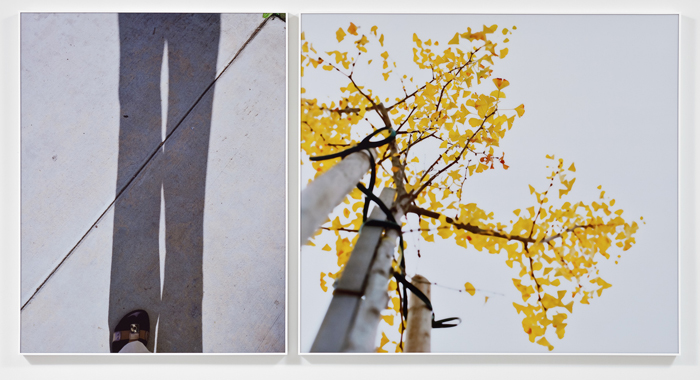
Uta Barth, Untitled (10.2), 2010. Mounted color photographs, framed. Two panels: 41 1/4 x 32 1/4 in., and 41 x 46 1/2 in. overall: 41 1/4 x 79 3/4 inches. No. 2 in edition of 6. Photo: Fredrik Nilsen. Courtesy of the artist and 1301PE.
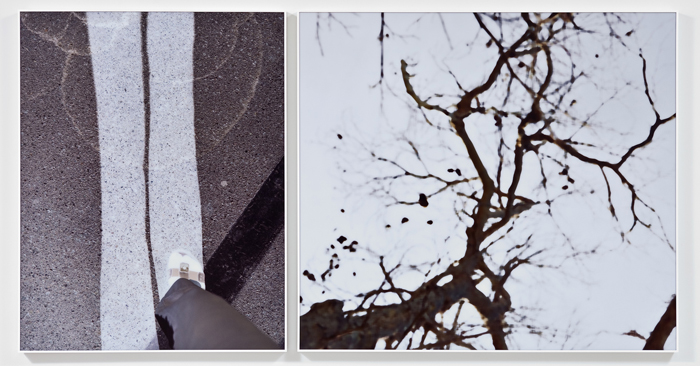
Uta Barth, Untitled (10.5), 2010. mounted color photographs, framed. two panels: 41 1/4 x 32 1/4 in. and 41 x 46 1/2 in. overall: 41 1/4 x 79 3/4 in. No. 2 in edition of 6. Photo: Fredrik Nilsen. Courtesy of the artist and 1301PE.
One locus of theoretical inspiration for the abundant possibilities of the walk—as both a means of exploring one’s environment, and a subversion of the bourgeois dictates of everyday life—can be found in the concept of the dérive, as articulated by Situationist Inter- national writer and filmmaker Guy Debord. Debord wrote in the essay “Theory of the Dérive” (1958): “When one or more individuals are involved in the dérive, they abandon… the customary rationales for movement and action…to succumb to the enticements of the terrain and the encounter associated with it.”3 A more contemporary paean to the mindful meander appears in Rebecca Solnit’s Wanderlust: A History of Walking: “The random, the unscreened, allows you to find what you don’t know you are looking for, and you don’t know a place until it surprises you. Walking is one way of maintaining a bulwark against this erosion of the mind, the body, the landscape, and the city…”4 Aspects of both ideas are manifest in walking works by Belgian artist Frances Alÿs, who stated in reference to his Seven Walks (2005): “…When you are walking, you are aware of, or awake to, everything that happens in your peripheral vision: the little incidents, smells, images, sounds. Walking brings a rich state of consciousness.”5
Like the above meditations on walking, Barth’s title for her exhibition, “…to walk without destination and see only to see,” evokes a receptive state of mind that is open to unpremeditated occurrences. But while her pieces display qualities of randomness when considered individually—the pose of the walker and the tree compositions read as casual—collectively the encounters with trees described by her photographs are carefully constructed to emphasize an aspect of perceptual experience. In actual (versus camera) vision, the eye selectively focuses at any given moment on merely a fraction of what we see before us. To illustrate this phenomenon, only small sections of foliage in each tree panel are sharp, and the rest blurred, in contrast to the crisply focused shadow-upon-pavement images.6 The result is a sort of tightly choreographed dance between the broader idea of a meander that inspires a heightened state of consciousness, and a finely tuned observation about perception.
A key point made in much writing about Barth’s work, including her own reflections, is the relative unimportance of the actual objects before her camera. In the suite white blind (bright red) (2002), for example, an image of tree branches against sky outside of Barth’s house is repeated multiple times. Each iteration represents a shift in perception that might occur over the course of a prolonged stare. The tree itself is incidental. However, in to walk, Barth’s trees exhibit considerable personality. Suffused with late afternoon light, the gingko, the maple, and the jacaranda appear radiant, poignantly elevated from their ordinary status as municipal plantings. The repetition of format also encourages awareness of the particulars of each: the shape, color and patterning of gold, red, brown, and green leaves in Untitled (10.2) (2010); Untitled (10.1) (2010); Untitled (10.4) (2010); and Untitled (10.3) (2010), and the wintry barrenness of Untitled (10.5). Indeed, the degree to which Barth’s subjects inhabit or resist the generic represents a fascinating tension within her work as a whole.
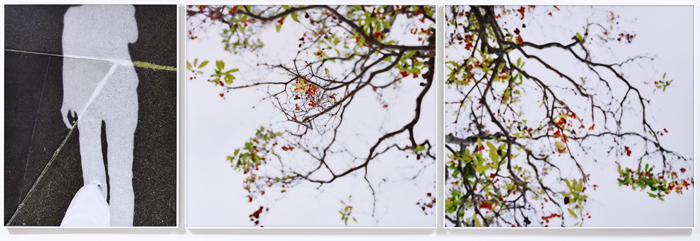
Uta Barth, Untitled (10.1), 2010. mounted color photographs, framed. three panels: 41 1/4 x 32 1/4 in., 41 x 46 1/2 in. and 41 x 46 1/2 in. overall: 41 1/4 x 127 1/4 in. No. 2 in edition of 6. Photo: Fredrik Nilsen. Courtesy of the artist and 1301PE.
The act of appreciating a landscape while walking brings to mind the nature hike where, in its most romantic form, the hiker enters a state of reverie induced by nature’s beauty—think Wordworth’s poem, “I Wandered Lonely as a Cloud” (1804). The twentieth century artistic embodiment of the nature hike is the practice of British land artist Richard Long. Long, one of the earliest artists to frame the walk as an artwork, documented solitary walks in remote locations, altering the landscape gently and impermanently as he hiked. He titled his works after the locations of the walks, the time it took him to complete them, and the simple shapes that his paths formed. Here, Barth also walks in order to depict objects of the landscape: trees, albeit urban ones. But while Long’s photographic documents—with their wide angles and deadpan sense of remove—make us aware of the gap between the experience of the walk and its realization as an art object, Barth’s photographs draw us into to an intimate act of seeing within the everyday realm of what we might actually experience.
Barth’s photographic materialization of urban walking feels more like a reverie than an actual or complete experience of an urban environment. If a walker derives pleasure—subversive, romantic, voyeuristic, or otherwise—from what is encountered along a route, these pictures reveals little in the way of details about location, or indentifying information about the trees pictured. Rather, to walk evokes an anonymous pedestrian body with which we identify by proxy. Each piece invites us to locate our body in the space between panels, and conveys a sense of physical immediacy commensurate with Barth’s well-documented interest in phenomenology.7 This effect is reinforced by the prints’ low hanging height: the top edge of each frame measures about five feet and four inches from the floor. Barth also circumvents the distancing effects of the singular frontal point of view so typical of photographs, whose metaphor is the window into the world, with its implied pane of glass separating viewer from subject. Although the pieces in to walk evoke the spirit of discovery and revelation redolent of Debord’s dérive, the nature hike, and Solnit’s philosophical reflections on walking, what distinguishes the project brings me back to the quieter aspects. Barth places her emphasis on subtle, fleeting optical and compositional variations that we might otherwise overlook: the selective blurring mentioned above, and slight shifts in framing. The gingko tree in Untitled (10.2) occupies only the left half of its frame, while the jacaranda in Untitled (10.3) fills its own. Colors, shapes, and textures emerge and recede.
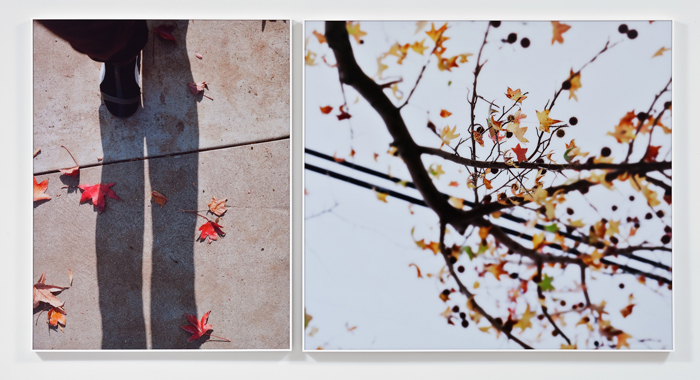
Uta Barth, Untitled (10.4), 2010. mounted color photographs, framed. two panels: 41 1/4 x 32 1/4 in and 41 x 46 1/2 in. overall: 41 1/4 x 79 3/4 inches. No. 2 in edition of 6. Photo: Fredrik Nilsen. Courtesy of the artist and 1301PE.
On the ground floor of the gallery are seven recently unearthed and elegantly reprinted works from Barth’s student years. Dated 1979–82 (2010), these small, square- format black and white prints are hung individually and in groups of up to sixteen sequenced images. They offer interesting and in some cases revelatory connections to aspects of Barth’s mature work, specifically her preoccupation with compositional framing and the behavior of light, her depiction of everyday environments, and her use of the anonymous figure. For example, in the eleven-panel piece One Day, the artist documented a day’s progression of the shadow of an unnamed figure cast from light passing through a sliding glass door onto a vinyl floor. And, in the diptych Untitled #1, a figure stands adjacent to, then enters, a rectangle of shadow cast upon a white wall. While elements of the student work are echoed in to walk, they appear more overtly in other recent projects, such as Sundial (2007), which records the passage of light on an interior space as a temporally ambiguous series of perceptual shifts. It was fun to observe the cocktail of playfulness and careful calculation evident to varying degrees in both displays. However, the inclusion of the student projects in a more extensive show of Barth’s work would allow a more satisfying look at the connections.
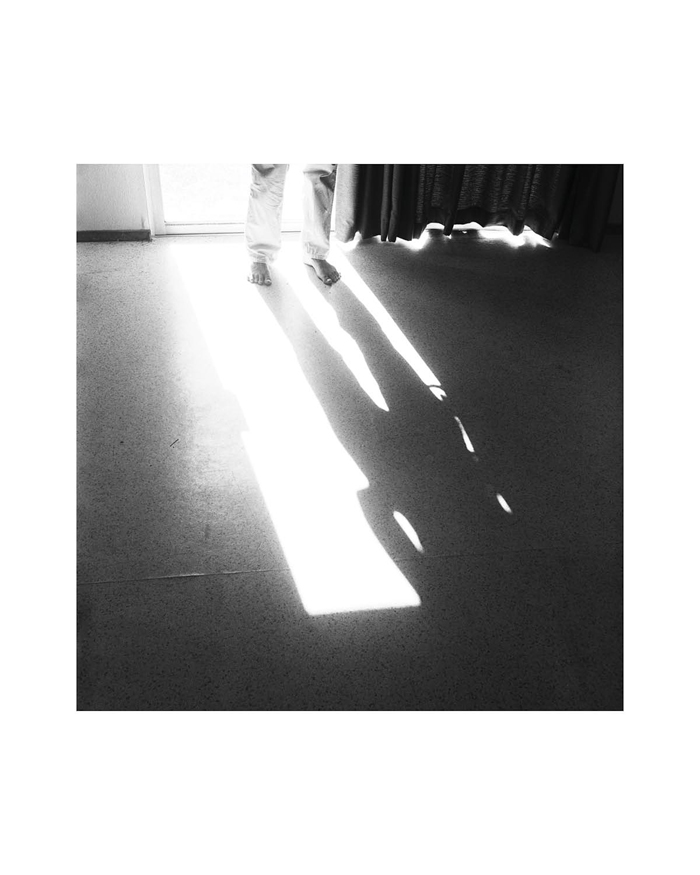
Uta Barth, One Day (detail), 1979-82/2010. Eleven framed inkjet photographs, 9 x 11 1/2 in. Photo: Fredrik Nilsen. Courtesy of the artist and 1301PE.
In her film The Gleaners and I (2000), Agnès Varda accidentally leaves the lens cap off her camera as she wanders through an abandoned vineyard in the hills above Apt in southeastern France.8 For several seconds, we observe a close-up landscape of leaves, vines, and grasses through the jerking motion of her camera, with the lens cap bobbing in the foreground. We experience the scene as if we are in Varda’s shoes, but with the awareness that this is a cinematic representation absent of the invisible processes by which a scene is rendered seamlessly “natural.” The clip replicates the pace at which one might actually encounter things while walking—a spray of dry leaves here, a careening tangle of brush there, a dancing cluster of grapes in the upper corner that slices across the frame. Barth’s newest project is a prolonged and structured version of Varda’s uncalculated moment: it might frustrate my desires for the documentary specifics of place, person, and meaning, but it brings me closer, as does walking, to a version of seeing more closely aligned with experience itself.
Audrey Mandelbaum is an artist, teacher, and writer who lives in Los Angeles.
